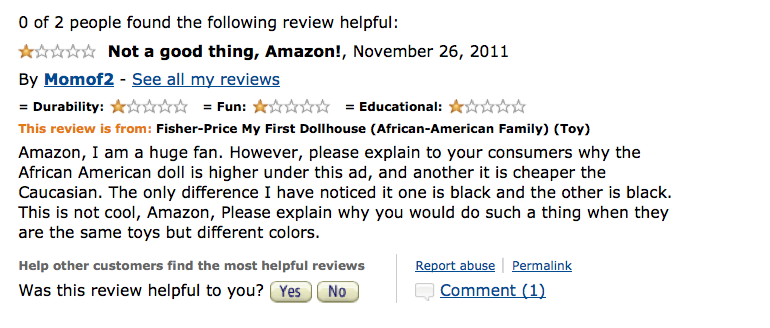Why Does a Caucasian Dollhouse Cost Nearly 70% More Than an African-American Dollhouse?
If you were shopping on Amazon.com last night for a Fisher-Price “My First Dollhouse” with a Caucasian family, you would have been asked to pay $63.99:

If, however, you wanted to buy what looks to be a nearly identical “My First Dollhouse” with an African-American family, the price was only $37.99:

Amazon reviewers have taken note, and aren’t pleased:

When my son Solomon (11 years old) wandered past my computer last night as I was looking this over, he didn’t need any prompting: “That’s so racist!” he said.
Is it? What is it that we’re seeing here on Amazon — racial discrimination? Price discrimination? Neither?
When I went back to the site this morning, I saw that the Caucasian dollhouse price had fallen to $55.87:

But the shipping fee was now $7.99, for a total of $63.86. The shipping fee for the $63.99 offer was only $0.99, for a total of $64.98. So the actual price had fallen only $1.12.
But the price change reveals something more telling. The two prices were offered by two different third-party vendors: H Books and Toys and Electronics Club.
The African-American dollhouse, meanwhile, is sold directly by Amazon.
I would assume that Amazon had no intention of charging such a steep premium for the Caucasian dollhouse but by creating a third-party marketplace, has opened itself up to this kind of discrepancy.
I have a few thoughts:
1. Amazon may not even be aware of this discrepancy.
2. Perhaps Amazon had bought from Fisher-Price a certain number of Caucasian dollhouses and offered them at the same price as the African-American dollhouses but the supply ran out, with the order now deferring to a more expensive third party.
3. If Amazon isn’t aware and becomes so — or if an outcry were to arise — it may well step in to strike down the unequal pricing. I would also imagine Fisher-Price would have something to say.
4. There is evidence that white and black children both prefer white dolls. So, the controversial element notwithstanding, are we simply seeing a demand-and-price story here?
5. I can easily see this scenario prompting a lawsuit, from someone, if only for show.
(HT: Younes Chajia)

Comments